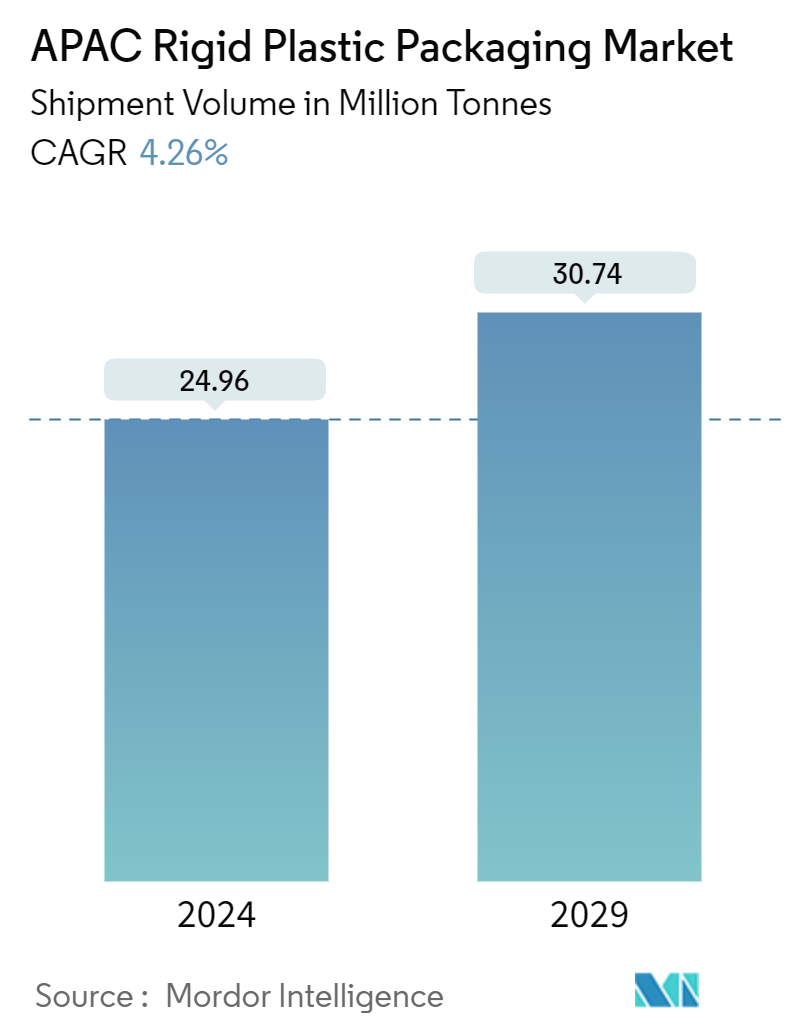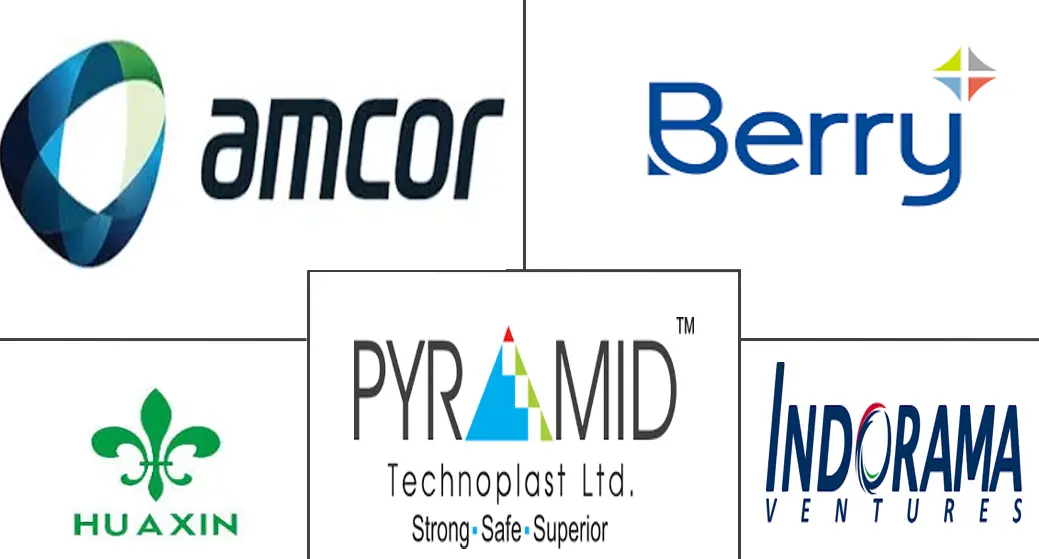Market Size of APAC Rigid Plastic Packaging Industry

| Study Period | 2019 - 2029 |
| Base Year For Estimation | 2023 |
| Forecast Data Period | 2024 - 2029 |
| Historical Data Period | 2019 - 2022 |
| CAGR (2024 - 2029) | 4.26 % |
| Market Concentration | Low |
Major Players
*Disclaimer: Major Players sorted in no particular order |
APAC Rigid Plastic Packaging Market Analysis
The APAC Rigid Plastic Packaging Market size in terms of shipment volume is expected to grow from 24.96 Million tonnes in 2024 to 30.74 Million tonnes by 2029, at a CAGR of 4.26% during the forecast period (2024-2029).
Plastic packaging has become more popular among consumers than other products because plastic is lightweight and indestructible, making it easy to handle. Even major manufacturers prefer plastic packaging because of the lower production costs. The introduction of polymers such as PET and HDPE is increasing the use of plastic bottles. The market for rigid plastic packaging is growing.
- China is a leading global player in both the production and consumption of plastics. The reliance on plastic bottles and containers, particularly those made from PET (polyethylene terephthalate), HDPE (high-density polyethylene), and other polymers, is rising across industries such as food and beverages, pharmaceuticals, and personal care. This trend has intensified China's focus on the production and export of plastics. Data from the International Trade Center (ITC) revealed that the United States is the primary destination for China's plastic exports. In 2023, China shipped 292.6 million tons of plastic products to the United States, marking an 8.00% increase from the previous year.
- The movement toward a healthier lifestyle is increasing in China. Consequently, consumers in China are more likely to opt for beverages that encourage a healthier lifestyle, and nutritional value is a key factor in the selection process. Dairy and protein drinks have seen a surge in popularity. To cater to the demand for healthier beverages, manufacturers are introducing new and innovative products or reformulating existing ones to align with health and wellness trends.
- The rigid plastic packaging market is expected to be negatively impacted by the growing awareness of environmental issues related to plastic, as well as other health concerns related to bottled water. Global warming and the amount of plastic waste are also expected to negatively impact the market’s growth.
- According to the Indian Railway Catering and Tourism Corporation, bottle production increased due to the increased consumption of water bottles and the expanding railway sector. In 2021, production stood at 75.30 million bottles, which rose to 357.70 million bottles in 2023.
- In response to heightened global media scrutiny on plastic pollution, Asian governments are swiftly implementing Extended Producer Responsibility (EPR) measures. Companies are urged to quickly adapt by measuring their plastic footprints, establishing ambitious yet realistic targets, and overhauling their packaging supply chains.
- The escalating plastic pollution in Southeast Asia spurred governments to adopt policies aimed at curbing plastic waste and championing sustainable packaging. They also encompass efforts like introducing plastic bans or taxes and enhancing waste management infrastructure, which may hamper the market growth in the upcoming years.
APAC Rigid Plastic Packaging Industry Segmentation
The study tracks the demand for rigid plastic packaging products catering to the food, foodservice, beverage, healthcare, personal care, cosmetic industries, industrial, building and construction, automotive, and other end-user industries. Rigid plastics can be of different grades and different material combinations based on the type of product being packed, like polyethylene, polypropylene, polyvinyl chloride, polyethylene terephthalate, and bio-plastics.
The Asia-Pacific rigid plastic packaging market is segmented by resin type (polyethylene (PE) (low-density polyethylene (LDPE) & linear low-density polyethylene (LLDPE) and high-density polyethylene (HDPE)), polyethylene terephthalate (PET), polypropylene (PP), polystyrene (PS) and expanded polystyrene (EPS), polyvinyl chloride (PVC), and other resin types), product type (bottles and jars, trays and containers, caps and closures, intermediate bulk containers (IBCs), drums, pallets, and other product types), end-user industry (food (candy & confectionery, frozen foods, fresh produce, dairy products, dry foods, meat, poultry, and seafood, pet food, and other food products), foodservice (quick service restaurants (QSRs), full service restaurants (FSRs), coffee and snack outlets, retail establishments, institutional, hospitality, and others foodservice sectors), beverages, healthcare, cosmetics and personal care, industrial, building and construction, automotive, and other end-user industries), and country (China, India, Japan, Thailand, Vietnam, Indonesia, and Australia and New Zealand, and Rest of Asia-Pacific). The market sizes and forecasts are provided in terms of volume (tonnes) for all the above segments.
| By Resin Type | ||||
| ||||
| Polyethylene terephthalate (PET) | ||||
| Polypropylene (PP) | ||||
| Polystyrene (PS) and Expanded polystyrene (EPS | ||||
| Polyvinyl chloride (PVC) | ||||
| Other Resin Types |
| By Product Type | |
| Bottles and Jars | |
| Trays and Containers | |
| Caps and Closures | |
| Intermediate Bulk Containers (IBCs) | |
| Drums | |
| Pallets | |
| Other Product Types |
| By End-use Industries | ||||||||||
| ||||||||||
| ||||||||||
| Beverage | ||||||||||
| Healthcare | ||||||||||
| Cosmetics and Personal Care | ||||||||||
| Industrial | ||||||||||
| Building and Construction | ||||||||||
| Automotive | ||||||||||
| Other End User Industries |
| By Country*** | |
| China | |
| India | |
| Japan | |
| Thailand | |
| Australia and New Zealand | |
| Indonesia | |
| Vietnam |
APAC Rigid Plastic Packaging Market Size Summary
The Asia-Pacific rigid plastic packaging market is poised for steady growth, driven by the increasing demand for lightweight and durable packaging solutions. The market's expansion is fueled by the rising popularity of plastic packaging among consumers and manufacturers due to its cost-effectiveness and ease of handling. The introduction of advanced polymers like PET and HDPE is further propelling the use of rigid plastic bottles, particularly in the beverage sector. As consumers in China and other regions shift towards healthier lifestyle choices, there is a growing demand for packaging that preserves the integrity and nutritional value of beverages. This trend is encouraging manufacturers to innovate and diversify their product offerings, necessitating specialized packaging solutions that cater to various beverage types and sizes.
Despite the positive growth trajectory, the rigid plastic packaging market faces challenges from environmental concerns and the impact of global events such as the Russia-Ukraine conflict, which has disrupted supply chains and increased production costs. The market is also influenced by regulatory shifts towards sustainable and recyclable packaging solutions. In response to these challenges, industry players are focusing on strategic acquisitions and partnerships to enhance their market presence and develop eco-friendly packaging options. Companies like Amcor, Berry Global, and PepsiCo are leading efforts to integrate sustainability into their operations, aligning with global initiatives to reduce plastic waste and promote a circular economy. The market's future growth will be shaped by urbanization, increased disposable incomes, and the evolving consumer lifestyle in the region.
APAC Rigid Plastic Packaging Market Size - Table of Contents
-
1. MARKET INSIGHTS
-
1.1 Market Overview
-
1.2 Industry Value Chain Analysis
-
1.3 Industry Attractiveness - Porter's Five Forces Analysis
-
1.3.1 Bargaining Power of Suppliers
-
1.3.2 Bargaining Power of Buyers/Consumers
-
1.3.3 Threat of New Entrants
-
1.3.4 Threat of Substitutes
-
1.3.5 Intensity of Competitive Rivalry
-
-
1.4 Trade Scenario
-
1.4.1 Trade Analysis (Top 5 Import-Export Countries)
-
-
1.5 Industry Regulation, Policy and Standards
-
1.6 Technology Landscape
-
1.7 Pricing Trend Analysis
-
1.7.1 Plastic Resins (Current Pricing and Historic Trends)
-
-
-
2. MARKET SEGMENTATION
-
2.1 By Resin Type
-
2.1.1 Polyethylene (PE)
-
2.1.1.1 Low-Density Polyethylene (LDPE) & Linear Low-Density Polyethylene (LLDPE)
-
2.1.1.2 High Density Polyethylene (HDPE)
-
-
2.1.2 Polyethylene terephthalate (PET)
-
2.1.3 Polypropylene (PP)
-
2.1.4 Polystyrene (PS) and Expanded polystyrene (EPS
-
2.1.5 Polyvinyl chloride (PVC)
-
2.1.6 Other Resin Types
-
-
2.2 By Product Type
-
2.2.1 Bottles and Jars
-
2.2.2 Trays and Containers
-
2.2.3 Caps and Closures
-
2.2.4 Intermediate Bulk Containers (IBCs)
-
2.2.5 Drums
-
2.2.6 Pallets
-
2.2.7 Other Product Types
-
-
2.3 By End-use Industries
-
2.3.1 Food**
-
2.3.1.1 Candy & Confectionery
-
2.3.1.2 Frozen Foods
-
2.3.1.3 Fresh Produce
-
2.3.1.4 Dairy Products
-
2.3.1.5 Dry Foods
-
2.3.1.6 Meat, Poultry, and Seafood
-
2.3.1.7 Pet Food
-
2.3.1.8 Other Food Products
-
-
2.3.2 Foodservice**
-
2.3.2.1 Quick Service Restaurants (QSRs)
-
2.3.2.2 Full-Service Restaurants (FSRs)
-
2.3.2.3 Coffee and Snack Outlets
-
2.3.2.4 Retail Establishments
-
2.3.2.5 Institutional
-
2.3.2.6 Hospitality
-
2.3.2.7 Others Food Service Sectors
-
-
2.3.3 Beverage
-
2.3.4 Healthcare
-
2.3.5 Cosmetics and Personal Care
-
2.3.6 Industrial
-
2.3.7 Building and Construction
-
2.3.8 Automotive
-
2.3.9 Other End User Industries
-
-
2.4 By Country***
-
2.4.1 China
-
2.4.2 India
-
2.4.3 Japan
-
2.4.4 Thailand
-
2.4.5 Australia and New Zealand
-
2.4.6 Indonesia
-
2.4.7 Vietnam
-
-
APAC Rigid Plastic Packaging Market Size FAQs
How big is the APAC Rigid Plastic Packaging Market?
The APAC Rigid Plastic Packaging Market size is expected to reach 24.96 million tonnes in 2024 and grow at a CAGR of 4.26% to reach 30.74 million tonnes by 2029.
What is the current APAC Rigid Plastic Packaging Market size?
In 2024, the APAC Rigid Plastic Packaging Market size is expected to reach 24.96 million tonnes.

